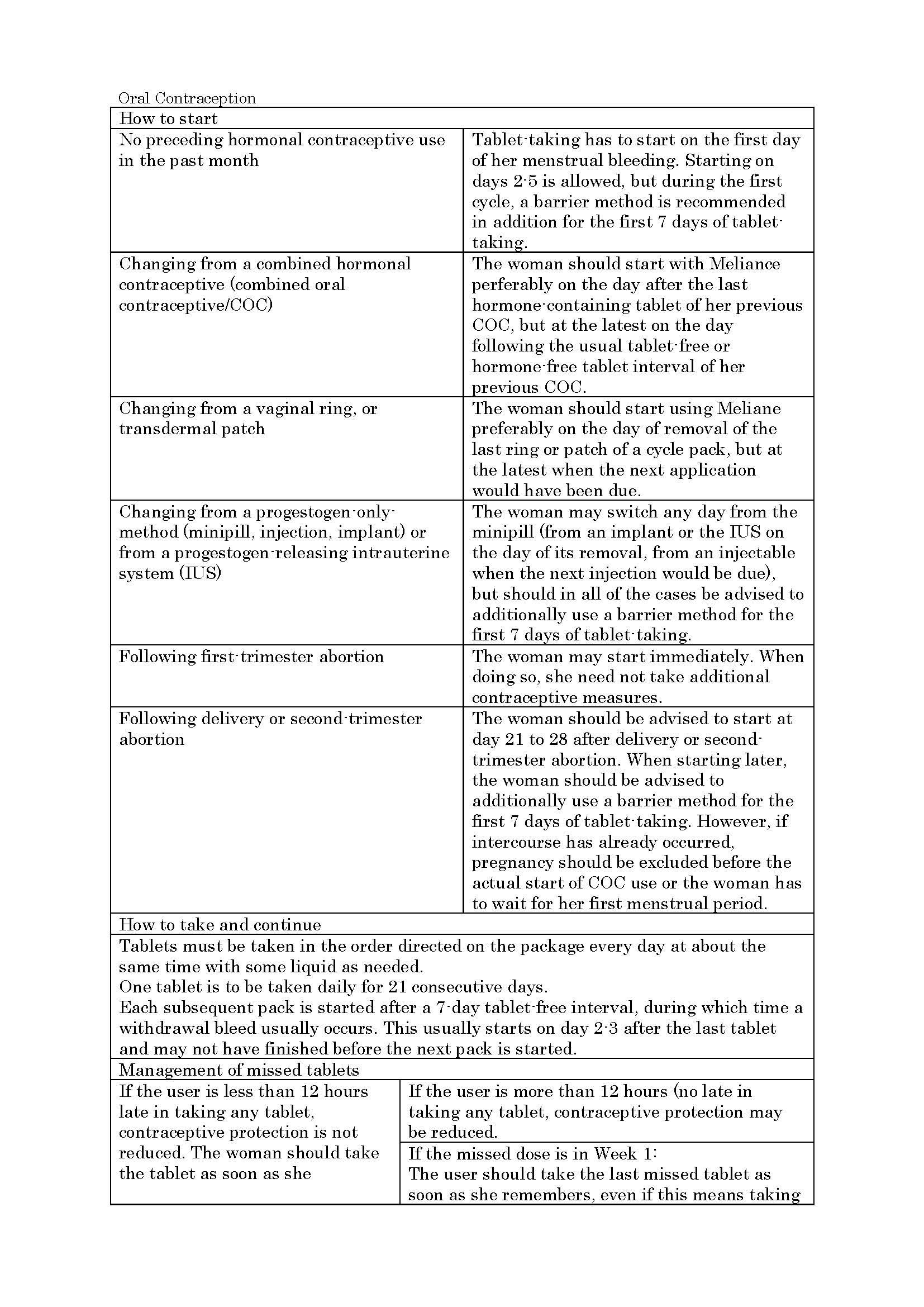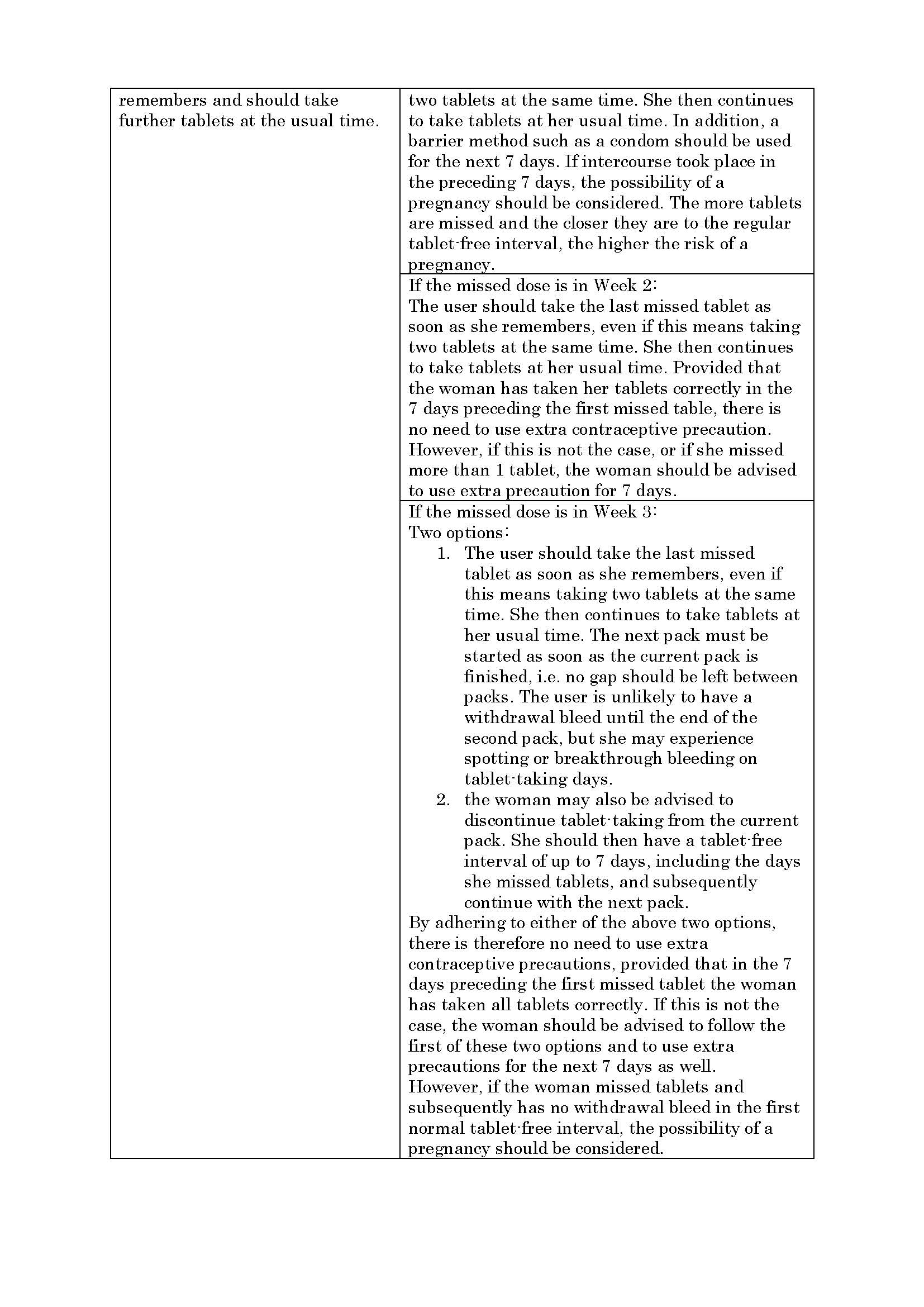MELIANE Tablet
ក្រុមហ៊ុនផលិតឱសថ:
Delpharm Lille S.A.S., France
ក្រុមហ៊ុនចែកចាយឱសថនៅប្រទេសកម្ពុជា:
DKSH


- សារធាតុសកម្ម
- ប្រសិទ្ធិភាពព្យាបាល និង កម្រិតប្រើប្រាស់
- ហាមប្រើ
- ផលរំខាន
- អន្តរប្រតិកម្ម
- ការប្រុងប្រយ័ត្នជាពិសេស បរិយាយប័ណ្ណឱសថ
-
សារធាតុសកម្ម
Gestodene 0.075mg, Ethinylestradiol 0.02mg
-
ប្រសិទ្ធិភាពព្យាបាល និង កម្រិតប្រើប្រាស់


-
ហាមប្រើ
ការហាមប្រើចំពោះ៖
- ស្ត្រីមានផ្ទៃពោះ ឬសង្ស័យថាមានផ្ទៃពោះ
- អ្នកមានជំងឺថ្លើមធ្ងន់ធ្ងរ ឬខាន់លឿង ឬមហារីកថ្លើម
- អ្នកមានរមាស់ពេញខ្លួនពេលមានផ្ទៃពោះលើកមុនៗ ឬ មាន Herpes
- អ្នកមានជំងឺខ្វះគ្រាប់ឈាមក្រហម Sickel cell
- អ្នកមានមហារីកដោះ ឬមហារីកក្នុងស្បូន
- អ្នកមានជំងឺទឹកនោមផ្អែមធ្ងន់ធ្ងរ
- អ្នកមានវិបត្តិមេតាបូលីសជាតិខ្លាញ់ក្នុងឈាម
- អ្នកខូចត្រចៀកស្ដាប់មិនសូវលឺ
- អ្នកធ្លាក់ឈាមតាមទ្វារមាសដោយមិនដឹងមូលហេតុ
- អ្នកធ្លាប់មានប្រតិកម្មជាមួយសារធាតុណាមួយនៃឱសថនេះ។Presence or risk of venous thromboembolism (VTE)*
- Presence or risk of arterial thromboembolism (ATE)*
- History of migraine with focal neurological symptoms
- Diabetes melitus with vascular symptoms
- Severe hypertension
- Severe dyslipoproteinaemia
- Severe hepatic disease
- Presence or history of liver tumours (benign or malignant)
- Known or suspected sex-steroid influenced malignancies (e.g. of the genital organs or the breasts)
- Undiagnosed vaginal bleeding
- Known or suspected pregnancy
- Hypersensitivity to the active substances or to any of the excipients
- Jaundice or persistent itching during a previous pregnancy
- Sickle cell anaemia
- Disturbance of lipometabolism
- History of herpes of pregnancy
- Otosclerosis with deterioration during pregnancy
-
ផលរំខាន
ផលរំខានរួមមាន៖
- មានការធ្លាក់ឈាមនៅពេលប្រើ 2-3ខែដំបូង តែបាត់ទៅវិញនៅពេលប្រើបានរយៈពេលយូរ។ ប្រសិនបើការធ្លាក់ឈាមមិនបាត់ឬមានបរិមាណច្រើននោះ ត្រូវពិគ្រោះជាមួយគ្រូពេទ្យ។
- ឈឺក្បាល ឈឺពោះ ដោះជ្រាយ ទម្ងន់ប្រែប្រួល។Common adverse reactions: nausea, abdominal pain, increased weight, headache, depressed mood, altered mood, breast pain, breast tenderness.
Serious adverse reactions:
- Symptoms of pulmonary embolism: Sudden onset of unexplained shortness of breath or rapid breathing; sudden coughing which may bring up blood; sharp chest pain which may increase with deep breathing; sense of anxiety; severe light headedness or dizziness; rapid or irregular heartbeat.
- Symptoms of a cerebrovascular accident: sudden numbness or weakness of the face, arm or leg, especially on one side of the body; sudden confusion, trouble speaking or understanding; sudden trouble seeing in one or both eyes; sudden trouble walking, dizziness, loss of balance or coordination; sudden, severe or prolonged headache with no known cause; loss of conciousness
- Symptoms of vascular occlusion: sudden pain, swelling and slight blue discoloration of an extremity; acute abdomen.
- Symptoms of MI: pain, discomfort, pressure, heaviness, sensation of squeezing or fullness in the chest, arm or below the breastbone; discomfort radiating to the back, jaw, throat, arm, stomach; fullness, indigestion or choking feeling; sweating, nausea, vomiting or dizziness; extreme weakness, anxiety, or shortness of breath; rapid or irregular heartbeats.
- Symptoms of liver tumors: severe upper abdominal pain, liver enlargement or signs of intra-abdominal hemorrhage.
- Crohn’s disease and ulcerative colitis
- Chloasma
-
អន្តរប្រតិកម្ម
គួរជៀសវាងប្រើជាមួយឱសថ : Griseofulvin, Phenylbutazone, Phenytoin, Phenobarbitone, Carbamazepine។
-
ការប្រុងប្រយ័ត្នជាពិសេស
ការប្រុងប្រយ័ត្ន៖
- ប្រសិនបើអ្នកប្រើមានអាការៈឬរោគសញ្ញាដូចខាងក្រោមនេះ ត្រូវឈប់ប្រើឱសថនេះ ហើយត្រូវទៅពិគ្រោះជាមួយគ្រូពេទ្យ៖
・ឈឺមួយចំហៀងក្បាល ឬឈឺក្បាលខ្លាំង ដែលកើតមានជាញឹកញាប់ដែលពីមុនពុំធ្លាប់មាន
・មានការប្រែប្រួលដល់គំហើញ ការស្ដាប់ និងការនិយាយ
・មានរោគសញ្ញាស្ទះសរសៃឈាមក្រហម ឬឈាមខ្មៅដូចជា : ឈឺឬហើមដៃ ចុកណែនដើមទ្រូង ក្រិនសរសៃជើង
・កើតរមាស់ពេញខ្លួន ឬស្បែកឡើងលឿង ឬឈឺពោះ
・សម្ពាធឈាមឡើង
- ប្រសិនបើអ្នកនឹងត្រូវធ្វើការវះកាត់នៅ 6ខែក្រោយ ឬត្រូវសំរាកនៅលើគ្រែយូរដោយគ្រោះថ្នាក់ចរាចរ ឬ វះកាត់ជើងនោះ ត្រូវផ្អាកការប្រើប្រាស់ឱសថ។see Package Insert about details.
・Circulatory Disorders
Epidemiological studies have suggested an association between the use of COCs and an increased risk of arterial and venous thrombotic and thromboembolic diseases such as myocardial infarction, stroke, deep venous thrombosis, and pulmonary embolism. These events occur rarely.
Other medical conditions which have been associated with adverse circulatory events include diabetes mellitus, systemic lupus erythematosus, hemolytic uremic syndrome, chronic inflammatory bowel disease (Crohn’s disease or ulcerative colitis) and sickle cell disease.
An increase in frequency or severity of migraine during COC use (which may be prodromal of a cerebrovascular event) may be a reason for immediate discontinuation of the COC. Biochemical factors that may be indicative of hereditary or acquired predisposition for venous or arterial thrombosis include Activated Protein C (APC) resistance, hyperhomocysteinemia, antithrombin-Ⅲdeficiency, protein C deficiency, protein S deficiency, antiphospholipid antibodies (anticardiolipin antibodies, lupus anticoagulant).
・Tumors
The most important risk factor for cervical cancer is persistent HPV infection. Some epidemiological studies have indicated that long-term use of COCs may further contribute to this increased risk but there continues to be controversy about the extent to which this finding is attributable to the confounding effects, e.g., cervical screening and sexual behavior including use of barrier contraceptives.
In rare cases, benign liver tumors, and even more rarely, malignant liver tumours have been reported in users of COCs. In isolated cases, these tumours have led to life-threatening intra-abdominal hemorrhages. A hepatic tumor should be considered in the differential diagnosis when severe upper abdominal pain, liver enlargement or signs of intra-abdominal hemorrhage occur in women taking COCs.
Malignancies may be life-threatening or may have a fatal outcome.
・Other conditions
Women with hypertriglyceridemia, or a family history thereof, may be at an increased risk of pancreatitis when using COCs.
Although small increases in blood pressure have been reported in many women taking COCs, clinically relevant increases are rare. A relationship between COC use and clinical hypertension has not been established. However, if a sustained clinically significant hypertension develops during the use of a COC then it is prudent for the physician to withdraw the COC and treat the hypertension. Where considered appropriate, COC use may be resumed if normotensive values can be achieved with antihypertensive therapy.
The following conditions have been reported to occur or deteriorate with both pregnancy and COC use, but the evidence of an association with COC use is inconclusive: jaundice and/or pruritus related to cholestasis; gallstone formation; porphyria; systemic lupus erythematosus; hemolytic uremic syndrome; Sydenham’s chorea; herpes gestationis; otosclerosis-related hearing loss.
In women with hereditary angioedema exogenous estrogens may induce or exacerbate symptoms of angioedema.
Acute or chronic disturbances of liver function may necessitate the discontinuation of COC use until markers of liver function return to normal. Recurrence of cholestatic jaundice which occurred first during pregnancy or previous use of sex steroids necessitates the discontinuation of COCs.
Although COCs may have an effect on peripheral insulin resistance and glucose tolerance, there is no evidence for a need to alter the therapeutic regimen in diabetics using low dose COCs (containing <0.05mg ethinylestradiol). However, diabetic women should be carefully observed while taking COCs.
Crohn’s disease and ulcerative colitis have been associated with COC use.
Chloasma may occasionally occur, especially in women with a history of chloasma gravidarum. Women with a tendency to chloasma should avoid exposure to the sun or ultraviolet radiation whilst taking COCs.
*ព័ត៌មានឱសថត្រូវបានរៀបរៀងដោយ អ៊ីម៉ាតុគឹ មេឌីក (ខេមបូឌា) ដោយផ្អែកលើប្រភពព័ត៌មានខាងក្រោម។ សម្រាប់ព័ត៌មានលម្អិត សូមស្វែងរកនៅក្នុងក្រដាសព័ត៌មាននៃឱសថនីមួយៗ ឬ សាកសួរទៅកាន់ក្រុមហ៊ុនឱសថឬតំណាងចែកចាយនៃឱសថនីមួយៗ។
ប្រភពព័ត៌មាន៖
- ក្រដាសព័ត៌មាននៃឱសថសម្រាប់អ្នកជំនាញវេជ្ជសាស្ត្រដែលប្រើប្រាស់នៅប្រទេសជប៉ុន (Pharmaceutical and Medical Devices Agency, Pmda): https://www.pmda.go.jp
- ព័ត៌មានសង្ខេបនៃឱសថសម្រាប់អ្នកជំងឺដែលប្រើប្រាស់នៅប្រទេសជប៉ុន: http://www.rad-ar.or.jp
